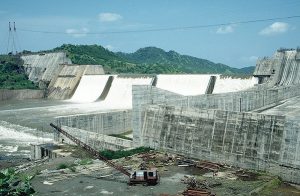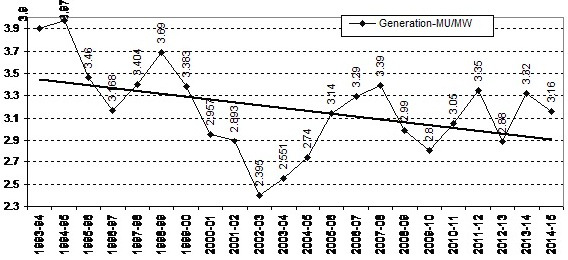Hydropower generation in India fell by over 4% last year, despite an increase in the country’s installed capacity, the latest figures from the Central Electricity Authority show.
More worryingly, the average generation per MW of hydropower capacity in India has fallen by 20% over the past two decades.
The government and power sector in India have been pushing for large hydropower projects. Here’s a graph that shows the rapid increase in installed capacity of large hydropower projects in India.
India had a total installed capacity of 40,885 MW from large hydropower projects (over 25 MW) as of March 2015. Another 15,000 MW of hydropower is under construction and 72,000 MW at various stages of approval and planning. However, the government and power sector have made been no attempt to credibly appraise performance of India’s hydropower projects.
The South Asia Network on Dams, Rivers and People (SANDRP) has been appraising large hydropower projects in India for some years. We have plotted the actual power generated from hydropower projects in India compared to total installed capacity of such projects since 1993, based on data from the Central Electricity Authority.
The figures clearly show diminishing generation from existing projects.
This should be a matter of serious concern, but neither the CEA nor other agencies are doing such an analysis. This exercise can also help identify what needs to be done to reverse this trend.
The falling generation cannot be attributed to lower monsoon rainfall, since rainfall has been average or above average in most of the years under consideration. Figures from the India Meteorological Department show that in 14 of the 22 years rainfall was above or near normal (above 98%), so the diminishing generation is not due to below normal monsoon.
89% of projects underperforming
Our analysis showed that 89% of the projects generate below expectations. The CEA approves hydropower projects based on the condition that projects will generate a certain amount of power 90% of the time. We compared these figures with actual generation for the last 29 years for operating projects, and found that 89% have underperformed. And half of these projects generated less than 50% of the promised power generation. This means a lot of these projects are unviable or have unviable capacity.
The reasons
There are many reasons why the generation per MW is dipping: unviable design, unviable installed capacities, over-optimistic hydrological assumptions, over development of river basins, catchment degradation, high rates of sedimentation, inadequate repair and maintenance, changing monsoon patterns due to climate change, increasing frequency of disasters, etc.
The destruction of forests, rivers, fisheries, biodiversity and submergence of lands is also exacerbating the impact of climate-related disasters for people and for the hydropower projects, as became clear during the June 2013 Uttarakhand disaster. All this should be part of our country’s impact assessment and decision-making processes.
Underperformers
State sector hydropower dams had the worst performance record in terms of energy generated in 2014-15. The generation of the Sardar Sarovar Narmada Nigam Limited’s Sardar Sarovar project fell by 50.31% and the Narmada Sagar and Omkareshwar dams (built by the Narmada Hydroelectric Development Corporation) fell by 36%. One reason was the unjustified depletion of the reservoir before the 2014 parliamentary elections.
There is no doubt that more detailed state wide and basin wide analyses would help, some of which are available in “Hydropower Performance” section of SANDRP website.
If the government and power sector continue to push for large hydropower projects without such analysis this will lead to even greater avoidable social, environmental and economic costs.
There are options
The first priority is to optimise generation from existing projects instead of pushing for new large hydropower projects. We need credible and comprehensive project level and basin wide cumulative social and environmental impact assessments and public consent in upstream and downstream areas.
There is a huge potential to develop small-scale hydropower (less than 1 MW) in the Himalayan and other mountain areas – to increase access to power among communities who have no electricity. These projects are cheaper, have less impact and can be built in a shorter time with the full involvement of local communities. Such projects should be take priority over larger projects.
As global trends show solar and wind power is growing faster than any other energy sector. This is also likely to be the trend in India as well as the cost of installing solar and wind power falls. One of the obstacles is that the solar and wind power is only available when there is sun and wind, and storage of surplus power is costly.
Pumped storage hydropower projects provide an option even for existing dams: when it’s sunny or windy, surplus power can be used to pump water from lower to higher elevation reservoirs. At night or when there is no wind, stored water can be released to power the same turbines to produce electricity.
No assessment of peaking power from dams
One of the unique selling points of hydropower projects is that they can provide power at times of peak demand, unlike coal or nuclear power projects.
However, no agency in India has the necessary data to analyse what proportion of hydropower is providing peak power. Without such an analysis it is not possible to optimise power generation from hydropower projects to meet peak demand.
If we do not monitor or try to optimise power generation, is there a case for pushing more hydro in the name of meeting peak power demands?
What about existing large dams?
Less than 3% of India’s large dams have a hydropower component, most are irrigation projects. Since the social, environmental and economic costs have already been paid for these projects, we need to assess the possibility of adding hydropower capacity to existing projects rather going for new hydropower projects. This is what the US is doing.
Before we build even more large hydropower projects at huge social, ecological and economic costs, we have to exhuast these alternatives.
Himanshu Thakker is the Coordinator of South Asia Network on Dams, Rivers and People (SANDRP). This blog post first appeared on the SANDRP Blog, here.


